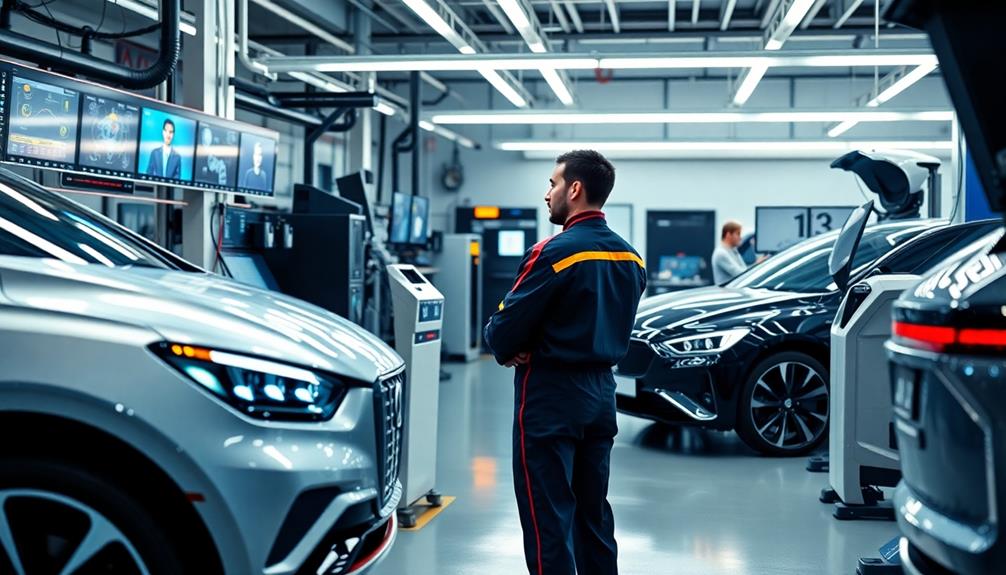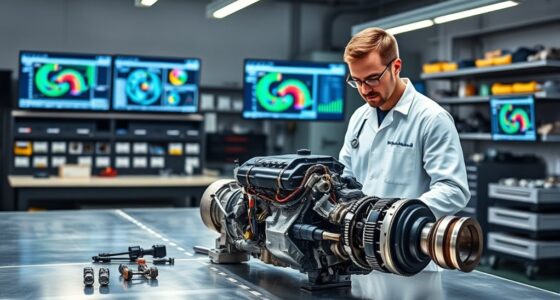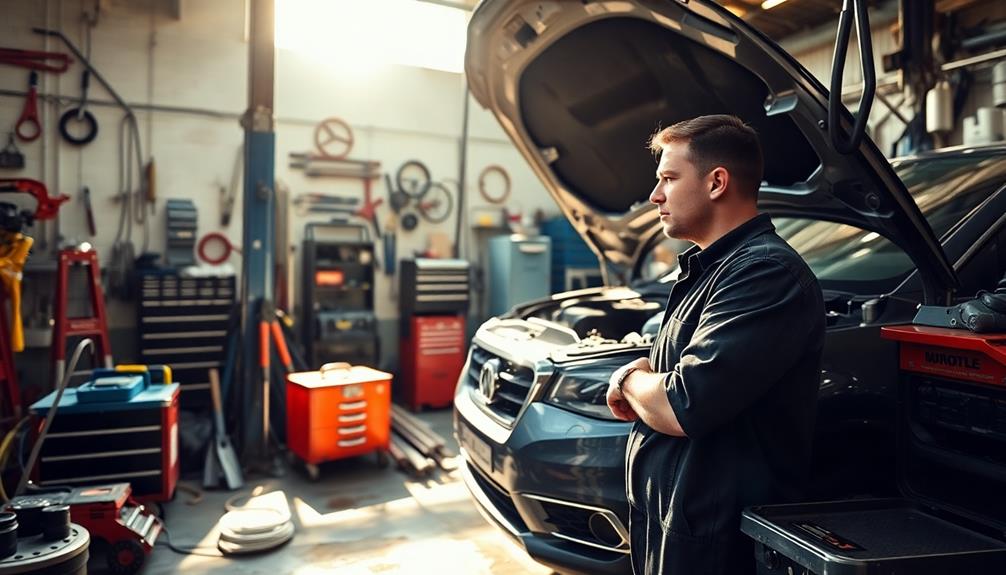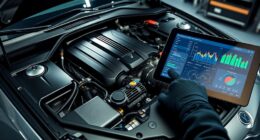Automotive repair is considered a high-tech field because today's vehicles are incredibly complex, containing around 60 microprocessors and over 10 million lines of software code. These advancements mean you'll need specialized knowledge and diagnostic tools to address electronic system issues effectively. With electronics making up 40-50% of vehicle costs, both manufacturers and repair shops invest heavily in research and development. As vehicles evolve—incorporating technologies like Advanced Driver Assistance Systems and electric drivetrains—the demand for trained technicians continues to rise. Stick around, and you'll discover more about the innovations shaping this dynamic industry.
Key Takeaways
- Modern vehicles contain approximately 60 microprocessors and over 10 million lines of software code, showcasing their technological complexity.
- Advanced Driver Assistance Systems (ADAS) rely on intricate networks of sensors and software for enhanced vehicle safety and performance.
- The automotive repair industry demands specialized skills, requiring at least 10% of its workforce to be engineers for effective diagnostics and repairs.
- Rapid advancements in electric vehicles and self-driving technology necessitate ongoing training and investment in high-tech diagnostic tools for repair shops.
- Predictive analytics and real-time diagnostics have transformed vehicle maintenance, improving service efficiency and customer experience through advanced technology integration.
Definition of High-Tech in Automotive
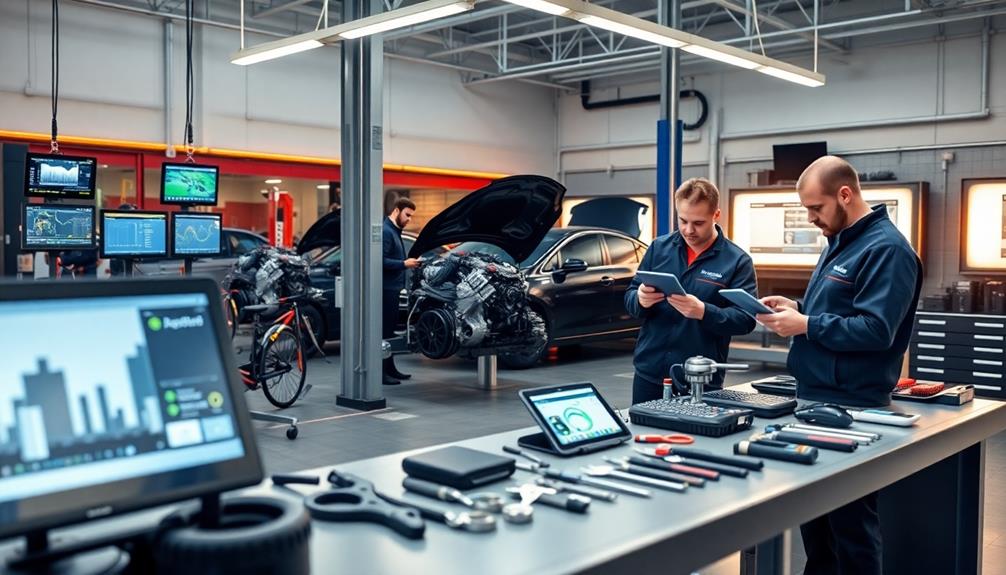
When you think about high-tech in the automotive industry, it's vital to recognize that modern vehicles are more than just machines; they're complex systems powered by advanced technology.
The automotive repair industry has evolved alongside these advancements, requiring a workforce where at least 10% are engineers, highlighting the technical expertise needed to maintain such sophisticated vehicles.
Today's cars come equipped with around 60 microprocessors, a number that's quadrupled in the last decade. This complexity brings about significant challenges in automotive repair.
Each vehicle contains over 10 million lines of software code, surpassing even the complexities found in advanced aircraft like the Boeing 787 Dreamliner. With electronics making up 40% to 50% of total vehicle costs, the role of technology in both manufacturing and maintenance has never been more vital.
Moreover, the automotive sector generates about 4,800 patents annually, showcasing a commitment to continuous innovation.
As you navigate the automotive repair industry, it's important to understand that high-tech isn't just a label; it's a fundamental aspect of how vehicles are designed, built, and serviced today.
Investment in Research and Development
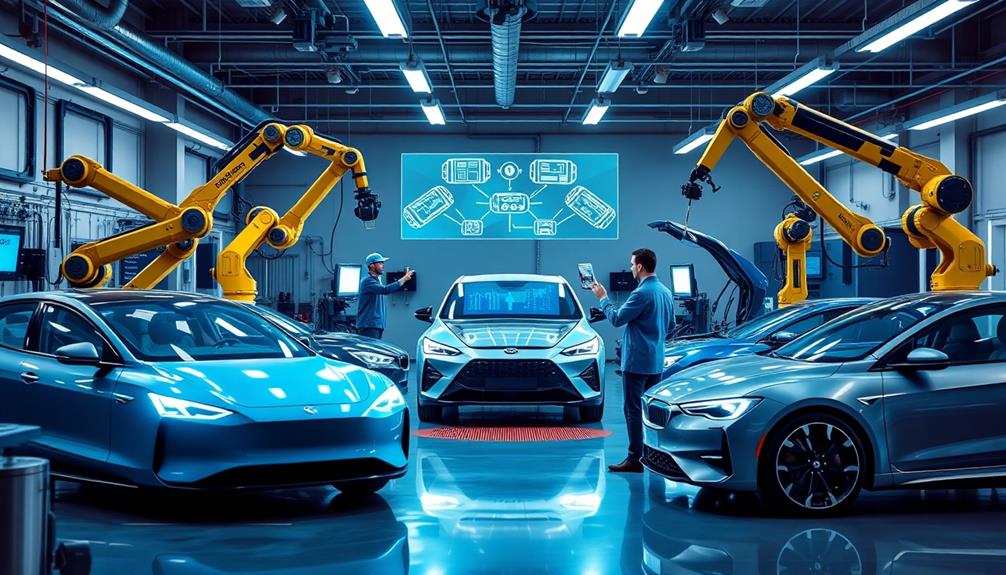
The automotive industry's commitment to high-tech advancements is evident in its substantial investment in research and development (R&D). On average, automakers spend about $1,200 on R&D for each vehicle manufactured globally. This investment reflects a strong focus on innovation, as major companies like GM and Ford often outspend tech giants such as General Electric and Apple.
IRA Investment Strategy underscores the importance of strategic investments in various sectors.
Consider these key points:
- Five leading automakers rank among the top 20 companies in corporate R&D spending.
- The industry secures approximately 4,800 patents annually, showcasing ongoing technological development.
- Continuous innovation is driven by market demands, resulting in advanced features and systems in modern vehicles.
- The automotive industry's R&D efforts emphasize safety, efficiency, and sustainability.
With such a significant investment in research and development, it's clear that the automotive industry isn't just about making cars; it's about shaping the future of transportation through cutting-edge technology.
As this investment continues, you can expect even more high-tech features and advancements, making automotive repair and maintenance increasingly complex and exciting.
Key Technological Components of Vehicles

You'll find that modern vehicles are packed with around 60 microprocessors and over 10 million lines of software code, making them incredibly complex machines.
This complexity requires advanced diagnostic tools to identify and fix issues effectively.
Understanding these key technological components is essential for anyone involved in automotive repair today.
Microprocessors and Software Complexity
In today's vehicles, an astounding number of microprocessors—around 60—work tirelessly to manage everything from engine performance to entertainment systems, a figure that has quadrupled in just ten years.
This explosion in microprocessor use highlights the growing complexity of automotive technology. You'll find that modern vehicles contain over 10 million lines of software code, surpassing the complexity of the Boeing 787 Dreamliner.
This increasing reliance on microprocessors and software leads to several key points:
- Advanced Driver Assistance Systems (ADAS) enhance safety and driving performance.
- Electronics account for 40% to 50% of the total vehicle cost, reflecting significant investment in high-tech components.
- Specialized tools and training are now essential for diagnosing and repairing issues related to software and electronic systems.
- Rapidly evolving technology demands that mechanics stay updated on the latest advancements.
As automotive technology becomes more sophisticated, repair professionals must adapt, making automotive repair a truly high-tech field.
Understanding these microprocessors and their role in vehicle performance is vital for anyone looking to succeed in this dynamic industry.
Advanced Diagnostic Tools
As the complexity of vehicles increases due to the proliferation of microprocessors and software, advanced diagnostic tools become essential for effective repairs. With modern vehicles housing around 60 microprocessors and over 10 million lines of software code, technicians need reliable tools to interface with these systems.
| Feature | Benefits |
|---|---|
| Predictive Analytics | Anticipates issues before they arise, reducing downtime. |
| Wi-Fi-Enabled Diagnostics | Allows for real-time updates and remote troubleshooting. |
| Code Readers | Quickly identifies error codes, speeding up the diagnostic process. |
| Manufacturer Compliance | Guarantees repairs meet specific standards, maintaining vehicle integrity. |
Advanced diagnostic tools not only help you pinpoint problems but also guarantee that repairs adhere to manufacturer specifications. Given that 40% to 50% of a vehicle's cost derives from electronics, having specialized knowledge in these tools is vital for any technician. Staying updated with the latest advancements allows you to maintain efficiency and effectiveness in vehicle maintenance, ultimately leading to better service and customer satisfaction. Embracing these tools is key to thriving in today's high-tech automotive repair landscape.
Innovation Through Patents

Innovation in the automotive industry is driven markedly by patents, which play an essential role in shaping the future of vehicle technology. Each year, the industry is granted around 4,800 patents, reflecting its commitment to innovation and advancement.
These patents cover a wide array of technologies, emphasizing the focus on enhancing vehicle performance, safety, and efficiency.
Here are some key aspects of patents in the auto repair industry:
- Competitive Edge: Patents protect innovations, allowing automakers to safeguard their investments.
- Incentives for R&D: Continuous patenting encourages manufacturers and suppliers to invest in research and development.
- Diverse Technologies: The range of patented technologies highlights the complexity of modern vehicles.
- Leadership in Innovation: The automotive sector's substantial patent output showcases its status as a leader in high-tech fields.
Future Workforce and Skills Needs
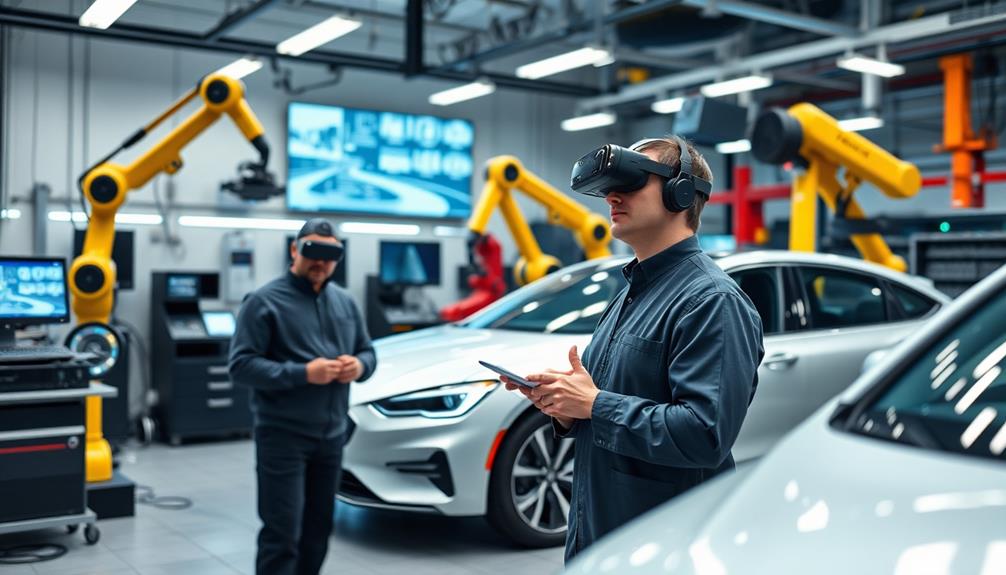
The rapid technological advancements in the automotive industry demand a workforce equipped with specialized skills to manage increasingly complex vehicles.
Today's cars contain over 10 million lines of software code and around 60 microprocessors, making it essential for you, as a technician, to have advanced training in high-tech repairs and diagnostics.
With electronics accounting for 40% to 50% of total vehicle costs, you need specialized knowledge in these systems to effectively maintain and repair modern vehicles.
Educational programs are evolving to emphasize high-tech component design and maintenance, ensuring the future workforce is prepared to meet these industry demands.
You'll find that proficiency with specialized tools and advanced diagnostic capabilities is becoming increasingly critical.
As automotive technology continues to change, a commitment to continuous learning and adaptation is crucial.
This highlights the necessity for skilled professionals in this high-tech field.
Latest Advancements in Automotive Technology

As you explore the latest advancements in automotive technology, you'll notice a significant shift towards smart vehicle integration and electric vehicle innovations.
These developments not only enhance vehicle performance but also transform how you approach repairs.
Advanced repair technologies, like augmented reality tools, are making diagnostics and fixes quicker and more accurate than ever before.
Smart Vehicle Integration
Smart vehicle integration is transforming the way you interact with your car, making driving safer and more enjoyable. As automotive technology advances, high-tech cars are now equipped with features that enhance your experience on the road.
Here's what makes smart vehicle integration essential:
- Real-time diagnostics: Get instant updates on your car's health and performance.
- Advanced Driver Assistance Systems (ADAS): Benefit from AI-driven features that help prevent accidents.
- Microprocessor integration: With about 60 microprocessors per vehicle, your car can handle complex tasks efficiently.
- Extensive software: Modern vehicles run over 10 million lines of code, showcasing the sophistication of their systems.
These advancements not only improve safety but also increase the overall efficiency of your driving experience.
With smart vehicle integration, you'll enjoy seamless connectivity through apps that keep you informed and engaged. The automotive industry is pushing boundaries, creating high-tech cars that redefine how you drive.
Embracing this technology means you're not just getting from point A to point B; you're experiencing a new era in automotive innovation.
Electric Vehicle Innovations
Electric vehicles (EVs) are revolutionizing the automotive landscape, offering cutting-edge advancements that not only enhance performance but also promote sustainability. As an automotive enthusiast or professional, you'll appreciate how electric cars are pivotal in reducing tailpipe emissions, helping improve air quality and protect the environment.
The market for these vehicles is booming, with a variety of models and price points available to cater to eco-conscious consumers. With advancements in high refresh rates for enhanced user experiences, the technology behind EVs continues to evolve.
One of the most exciting innovations is in battery technology. Solid-state batteries are making electric cars more competitive with traditional combustion-engine vehicles by considerably increasing their range and performance.
Additionally, the integration of smart technology allows for features like over-the-air software updates, enhancing functionality and user experience while minimizing the need for physical service visits.
However, as these cars advance, they require specialized diagnostics and repair techniques. This highlights the growing need for high-tech training among automotive technicians, ensuring they're equipped to handle the sophisticated electronic systems found in electric vehicles.
Embracing these innovations, you'll find that the future of automotive repair is undeniably high-tech, driven by the rapid evolution of electric cars.
Advanced Repair Technologies
The automotive industry is witnessing a remarkable shift towards advanced repair technologies that mirror the innovations found in electric vehicles. With modern vehicles boasting over 60 microprocessors and 10 million lines of software code, the complexity of automotive repair has skyrocketed. This evolution requires technicians to adapt and embrace cutting-edge tools and techniques.
Here's what you can expect with advanced repair technologies:
- Augmented Reality: Technicians can access live diagnostics and repair guidance, minimizing reliance on outdated service manuals.
- Predictive Analytics: This technology helps anticipate maintenance needs, enhancing service efficiency and boosting customer satisfaction.
- Advanced Driver Assistance Systems (ADAS): These systems require specialized knowledge to maintain, as they utilize sophisticated sensors and algorithms.
- Enhanced Diagnostic Tools: Modern tools enable precise troubleshooting, making it easier to identify and fix issues quickly.
As electric vehicles continue to rise, the shift from mechanical to electronic systems makes specialized training essential.
Embracing these advanced repair technologies not only keeps you competitive in the field but also guarantees the safety and efficiency of the vehicles you service.
Electric Vehicle Impact
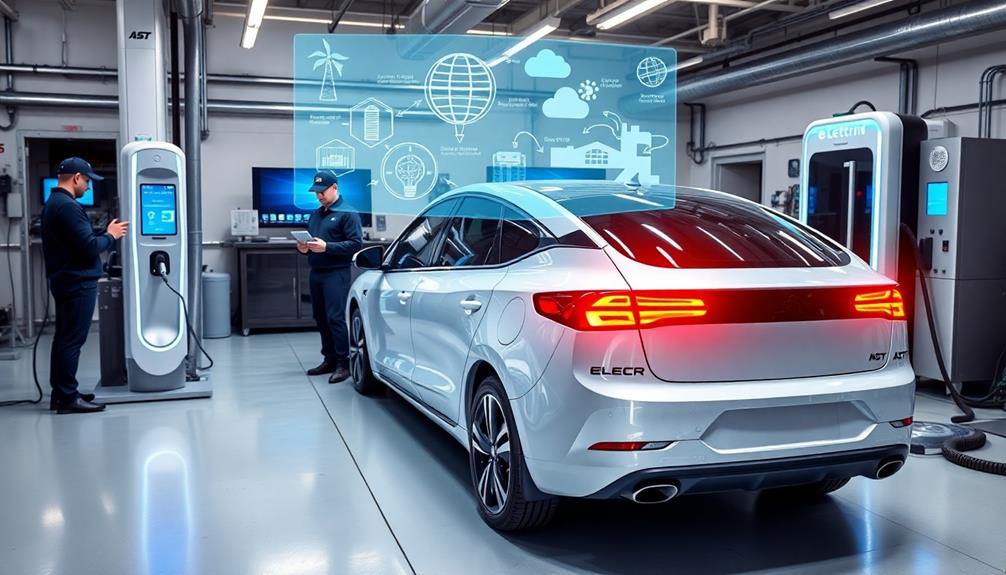
With the growing popularity of electric vehicles (EVs), auto repair shops face a significant transformation in their service offerings.
You'll need to adapt to the advanced diagnostic tools and software that EVs demand, as their complex electronic systems differ greatly from traditional mechanical components. This shift requires you to invest in specialized training for technicians, emphasizing high-voltage systems, battery management, and regenerative braking technologies.
As you embrace this change, keep in mind that around 40% to 50% of the total cost of modern vehicles comes from electronics. This means the repair of EVs will increasingly rely on high-tech solutions and equipment.
You might notice a decline in mechanical repair needs, but this also highlights the growing demand for expertise in electronic systems and software diagnostics.
The expanding market for EVs means you must prioritize cutting-edge technology in your auto repair shop, ensuring you can meet these vehicles' unique maintenance requirements.
Self-Driving Car Development

As electric vehicles reshape the automotive landscape, self-driving car development emerges as another significant technological advancement.
These self-driving cars rely on a sophisticated blend of sensors, cameras, and artificial intelligence to navigate, drastically minimizing human error. The technology behind these vehicles isn't just about hardware; it demands advanced software engineering skills to create complex algorithms that can process extensive data from the vehicle's environment.
Additionally, the integration of zero harmful emissions from hydrogen fuel cells highlights the potential for a cleaner, more sustainable future in automotive technology.
Key aspects of self-driving car development include:
- Significant investments from major automotive and tech companies, pouring billions into research and development.
- The necessity for advanced algorithms that can make real-time decisions in various driving scenarios.
- Ongoing regulatory challenges and ethical considerations surrounding public safety and machine decision-making.
- Enhanced safety features through the integration of advanced driver-assistance systems (ADAS), such as automatic emergency braking.
As the self-driving auto industry evolves, it's clear that these vehicles represent a leap into a future where technology and transportation intersect in unprecedented ways.
You'll see that understanding this development isn't just for enthusiasts; it's essential for anyone involved in automotive repair and innovation.
Advanced Driver Assistance Systems
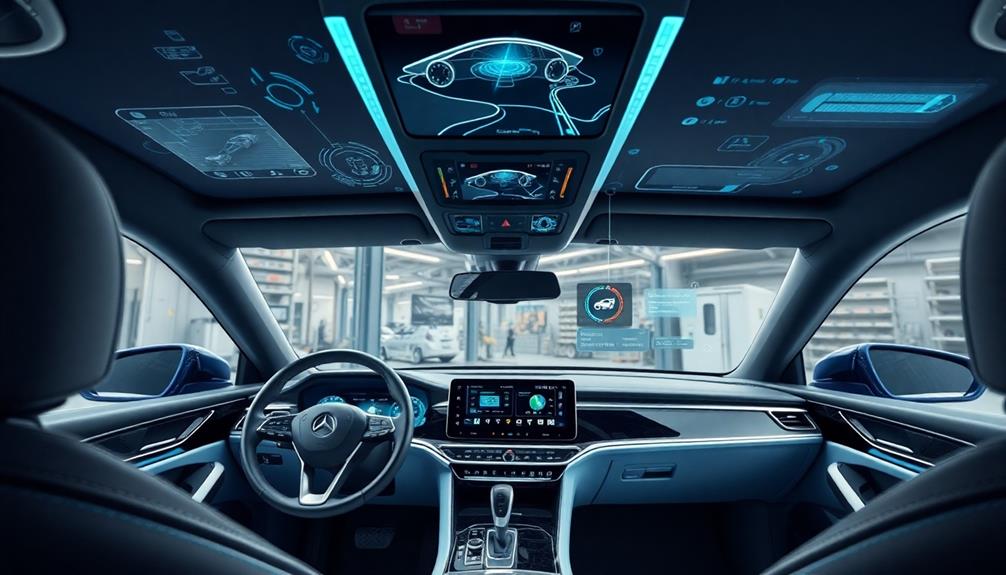
Advanced Driver Assistance Systems (ADAS) are revolutionizing the way we think about vehicle safety and driving experience. These systems, which include technologies like Adaptive Cruise Control, Automatic Emergency Braking (AEB), and Lane Departure Warning, aim to reduce human error on the road. By leveraging a network of sensors, cameras, and radar, ADAS provides real-time data to assist you in making safer driving decisions.
As these features become more prevalent, the automotive industry is witnessing a major shift toward safety-oriented technology. While extensive ADAS setups are often found in luxury vehicles, their adoption is spreading across various models. This evolution is vital, as studies show a significant reduction in accident rates where these systems are integrated.
However, the complexity of ADAS doesn't come without challenges. To guarantee these systems function correctly, trained technicians are essential. They require specialized training and advanced diagnostic tools for proper calibration.
| Feature | Impact on Safety |
|---|---|
| Adaptive Cruise Control | Maintains safe distance from other vehicles |
| Automatic Emergency Braking (AEB) | Reduces collision severity |
| Lane Departure Warning | Helps prevent unintentional lane changes |
| Blind Spot Detection | Increases awareness of surroundings |
| Parking Assistance | Simplifies parking situations |
Challenges for Repair Shops

The challenges facing repair shops today are significant and multifaceted. As vehicles become increasingly complex, your shop must adapt to a host of new hurdles that could impact your operations and customer satisfaction.
Here are some key challenges you might encounter:
- Advanced Technology Requirements: With modern vehicles containing around 60 microprocessors and over 10 million lines of code, specialized training and advanced diagnostic tools are essential.
- Longer Repair Times: The average repair duration has increased by 2.1 days, largely due to extensive calibration needed for advanced driver-assistance systems.
- High Equipment Costs: Investing in equipment like alignment tools (around $70,000) and calibration targets (approximately $30,000) can strain your finances.
- Increased Wait Times: The consolidation of independent auto shops has led to scheduling backlogs, which have doubled from 1.7 weeks in 2019 to 3.4 weeks.
To thrive in this high-tech environment, repair shops must embrace training and technology while managing costs and customer expectations effectively.
Maneuvering through these challenges will be essential for remaining competitive in the automotive repair industry.
Frequently Asked Questions
What Is the Difference Between a Mechanic and an Automotive Tech?
A mechanic primarily handles physical repairs, like engines and brakes, while an automotive tech specializes in diagnosing and fixing complex electronic systems. You'll find techs working with advanced software and high-tech components in modern vehicles.
What Is the Hardest Job for a Mechanic?
Ever tried untangling a web of wires while blindfolded? Diagnosing advanced driver-assistance systems is the hardest job for you as a mechanic, demanding precision and expertise to calibrate sensors and guarantee everything functions seamlessly.
Why Are Automotive Technicians Important?
You'll find automotive technicians are essential because they diagnose and repair complex systems in vehicles. Their expertise guarantees safety features work properly, enhances vehicle performance, and keeps up with technological advancements, meeting the evolving demands of modern drivers.
What Is the Automotive Repair Industry?
The automotive repair industry blends traditional skills with cutting-edge technology. You'll tackle mechanical issues while maneuvering complex software systems. This ever-evolving field demands your expertise, ensuring vehicles stay safe, efficient, and ready for the road. In this dynamic environment, professionals must stay updated with the latest advancements, from diagnostics tools to electric vehicle systems. Mastering both hands-on techniques and digital solutions is crucial for providing high-quality automobile repair and maintenance. By combining these skills, you can deliver services that optimize performance and extend the lifespan of modern vehicles.
Conclusion
In the ever-evolving world of automotive repair, think of your vehicle as a complex symphony, where each part plays a vital note. As you drive into the future, the high-tech innovations—electric engines, self-driving capabilities, and advanced safety systems—create an intricate melody that demands skilled hands and sharp minds. Embracing this transformation isn't just about fixing cars; it's about tuning into a new era of technology that connects us all, ensuring every journey hits the right note.
